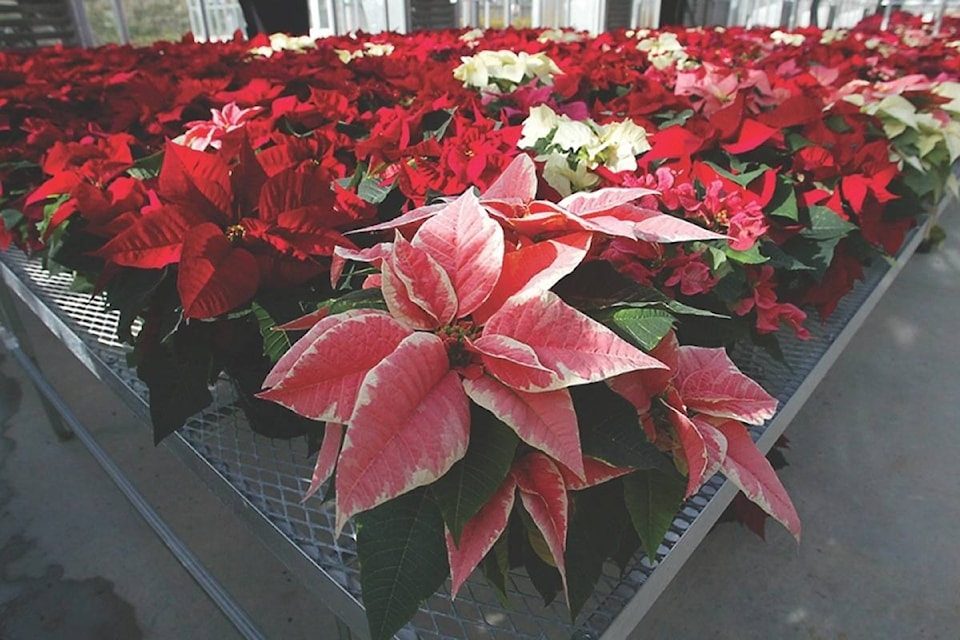Poinsettias, which are now considered part of Christmas greenery in North America, have been for sale for a couple of weeks. They are part of the Euphorbiaceous Family, which oozes a white sticky liquid when a stem is broken. The liquid can be messy, occasionally it will irritate the skin and stomach but it is not poisonous to animals or people.
These colorful, shapely plants arrive at greenhouses as plugs, or cuttings during the summer. The path between cuttings and blooming plant requires hard work, and precise timing.
Stems are pinched back to a set number of leaves dependent on the variety. Without being pinched the plants would grow tall and gangly as they do in the wild. Pinching lowers the height of the plant as well as increases the number of colorful bracts that make the plant attractive.
Soil is porous, watering and fertilization happens on a regulated schedule. Poinsettias do not react well to wet damp soil or a high pH.
Black out cloths and lights are used to insure that the plants receive the exact amount of light and dark needed for the bracts to turn color.
The crop like all greenhouse crops are monitored for insects and diseases. As there are large acreages of poinsettias grown in one area infestations can be disastrous.
As the crops matures, greenhouses are filled with reds, pinks and white. Plants are slipped into plastic sleeves, boxed and shipped out according to customer’s needs.
Once in the store, plants are moved from the box. Sometimes the sleeves are removed but not always as the sleeves protect the plant from breaking branches and allows it to take up less space. The sleeves also make it hard to water the plant and for a customer to determine its exact shape.
When purchasing a plant, pull down the plastic to see how bushy the plant is. Also check to see if the bottom leaves are intact. Poinsettias are notorious for dropping bottom leaves when stressed which can be caused by: lack of or too much moisture, cool temperatures and drafts.
Try to purchase poinsettias on days when the temperature is zero or above. Even then, have the vehicle warm and if possible wrap the plant in a couple layers before leaving the store.
Place the plant in a bright sunny area away from drafts, warm or cold. The plant prefers temperatures between 55 – 70 ˚F (12-21˚C). Higher temperatures usually result in falling bracts.
Before watering the container, look to see if it contains more than one stem. If so, spread the water evenly in the container to ensure all plants are watered. Check the moisture level before watering as poinsettias are native to Mexico and do not like to have wet roots.
The majority of Poinsettias that are grown for the holiday season are discarded early in the new year when the plant starts to look straggly. A few plants will be placed in a perfect location and the bracts can retain color and be attractive for a number of months making an attractive houseplant.
In February or March cut the branches back to approximately 4 inches (10 cm). Each branch should contain 1 to 3 leaves. The plant will slowly start to bush out.
Repot the plant when the days are warmer and place it outside in semi-shade or move it out of direct sunshine when left in the house.
To get the plant to bloom again, the plant must receive 12 hours of light and 12 hours of darkness for 10 weeks. Mistakes made with the light will stop the bracts from becoming colorful. Those wishing for December blooms should start the light-dark regime near the end of September.
Growing an attractive poinsettia in the home can be a challenge but they do add color to the holiday season.
Linda Tomlinson is a horticulturalist lives near Rocky Mountain House. She can be reached at your_garden@hotmail.com
